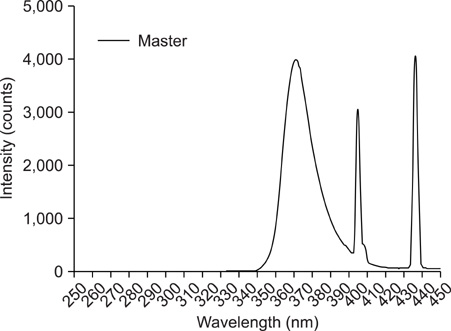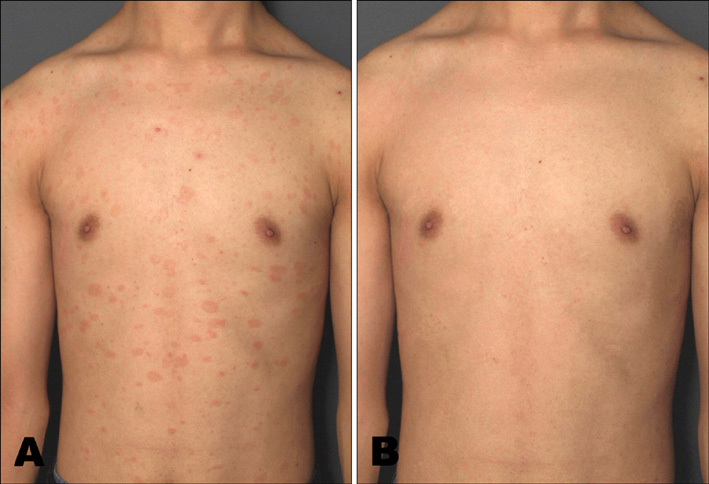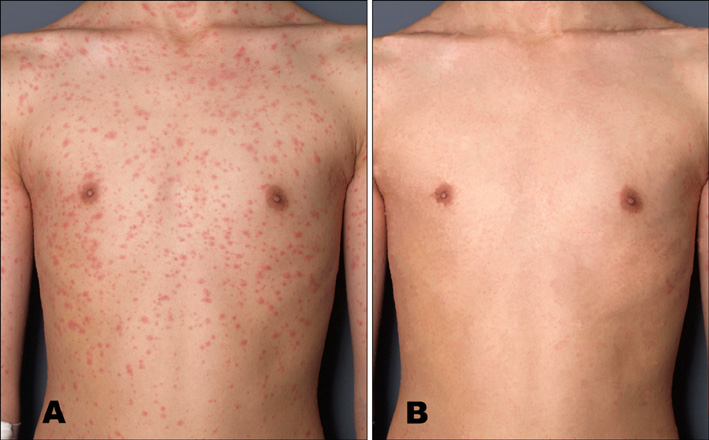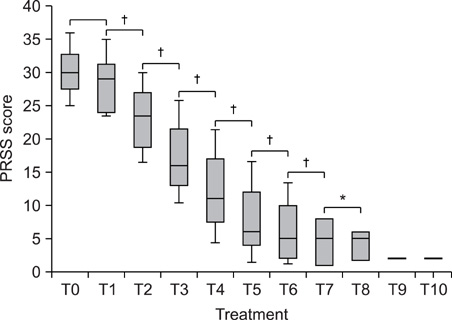Ann Dermatol.
2009 Aug;21(3):230-236. 10.5021/ad.2009.21.3.230.
Low-dose Ultraviolet A1 Phototherapy for Treating Pityriasis Rosea
- Affiliations
-
- 1Department of Dermatology, Konkuk University School of Medicine, Seoul, Korea. cyb@kuh.ac.kr
- KMID: 2266282
- DOI: http://doi.org/10.5021/ad.2009.21.3.230
Abstract
-
BACKGROUND: UVA1 phototherapy has recently demonstrated high levels of efficacy and tolerability for treating a variety of inflammatory and neoplastic skin diseases.
OBJECTIVE
The purpose of the present study was to assess the clinical efficacy of UVA1 (340~400 nm) phototherapy for treating pityriasis rosea and to assess the course of the disease after treatment.
METHODS
Fifteen patients with extensive pityriasis rosea were treated with low-dose UVA1 phototherapy (starting at 10~20 J/cm2 and then it was increased to 30 J/cm2). The treatments were given 2~3 times a week until complete clearance of lesions was achieved or until there was partial improvement without further amelioration, in spite of 5 additional treatments. The rate of clearing was monitored by estimating the pityriasis rosea severity (PRSS) score and the pruritus score.
RESULTS
The extent of disease (PRSS) in all 15 patients lessened during the study (30.1+/-3.6 vs. 2.0+/-1.6, respectively, p<0.05). The overall reduction of the PRSS showed a significant improvement after the second or third treatment. The pruritus of 12 of 15 patients lessened during the treatment period, and it was unchanged in the remaining 3 patients. The mean previous duration of disease was 11.2+/-4.9 days and this did not interfere with the successful outcome of UVA1 phototherapy.
CONCLUSION
This study shows that UVA1 phototherapy is a useful, well-tolerated treatment option for patients suffering from pityriasis rosea with extensive eruptions and considerable pruritus.
Figure
Reference
-
1. Chuh AA, Chiu SS, Peiris JS. Human herpesvirus 6 and 7 DNA in peripheral blood leucocytes and plasma in patients with pityriasis rosea by polymerase chain reaction: a prospective case control study. Acta Derm Venereol. 2001. 81:289–290.
Article2. Wong WR, Tsai CY, Shih SR, Chan HL. Association of pityriasis rosea with human herpesvirus-6 and human herpesvirus-7 in Taipei. J Formos Med Assoc. 2001. 100:478–483.3. Drago F, Ranieri E, Malaguti F, Battifoglio ML, Losi E, Rebora A. Human herpesvirus 7 in patients with pityriasis rosea. Electron microscopy investigations and polymerase chain reaction in mononuclear cells, plasma and skin. Dermatology. 1997. 195:374–378.
Article4. Cheong WK, Wong KS. An epidemiological study of pityriasis rosea in Middle Road Hospital. Singapore Med J. 1989. 30:60–62.5. Stulberg DL, Wolfrey J. Pityriasis rosea. Am Fam Physician. 2004. 69:87–91.6. Gonzalez LM, Allen R, Janniger CK, Schwartz RA. Pityriasis rosea: an important papulosquamous disorder. Int J Dermatol. 2005. 44:757–764.
Article7. Alf B, Eva T. Freedberg IM, Eisen AZ, Wolf K, Austen KF, Goldsmith LA, Katz SI, editors. Pityriasis rosea. Fitzpatrick's dermatology in general medicine. 2003. 6th ed. New York: McGraw-Hill;445–449.8. Merchant M, Hammond R. Controlled study of ultraviolet light for pityriasis rosea. Cutis. 1974. 14:548–549.9. Baden HP, Provan J. Sunlight and pityriasis rosea. Arch Dermatol. 1977. 113:377–378.
Article10. Plemmons JA. Pityriasis rosea: an old therapy revisited. Cutis. 1975. 16:120–121.11. Arndt KA, Paul BS, Stern RS, Parrish JA. Treatment of pityriasis rosea with UV radiation. Arch Dermatol. 1983. 119:381–382.
Article12. Dawe RS. Ultraviolet A1 phototherapy. Br J Dermatol. 2003. 148:626–637.
Article13. Beattie PE, Dawe RS, Ibbotson SH, Ferguson J. UVA1 phototherapy for treatment of necrobiosis lipoidica. Clin Exp Dermatol. 2006. 31:235–238.
Article14. Abeck D, Schmidt T, Fesq H, Strom K, Mempel M, Brockow K, et al. Long-term efficacy of medium-dose UVA1 phototherapy in atopic dermatitis. J Am Acad Dermatol. 2000. 42:254–257.15. Kowalzick L. UVA1 for atopic dermatitis: medium dose superior to low dose. J Am Acad Dermatol. 2001. 44:548.
Article16. Krutmann J, Diepgen TL, Luger TA, Grabbe S, Meffert H, Sonnichsen N, et al. High-dose UVA1 therapy for atopic dermatitis: results of a multicenter trial. J Am Acad Dermatol. 1998. 38:589–593.
Article17. Grabbe J, Welker P, Humke S, Grewe M, Schopf E, Henz BM, et al. High-dose ultraviolet A1 (UVA1), but not UVA/UVB therapy, decreases IgE-binding cells in lesional skin of patients with atopic eczema. J Invest Dermatol. 1996. 107:419–422.
Article18. Camacho NR, Sanchez JE, Martin RF, Gonzalez JR, Sanchez JL. Medium-dose UVA1 phototherapy in localized scleroderma and its effect in CD34-positive dendritic cells. J Am Acad Dermatol. 2001. 45:697–699.
Article19. Gruss C, Stucker M, Kobyletzki G, Schreiber D, Altmeyer P, Kerscher M. Low dose UVA1 phototherapy in disabling pansclerotic morphoea of childhood. Br J Dermatol. 1997. 136:293–294.
Article20. de Rie MA, Enomoto DN, de Vries HJ, Bos JD. Evaluation of medium-dose UVA1 phototherapy in localized scleroderma with the cutometer and fast Fourier transform method. Dermatology. 2003. 207:298–301.
Article21. Kreuter A, Breuckmann F, Uhle A, Brockmeyer N, Von Kobyletzki G, Freitag M, et al. Low-dose UVA1 phototherapy in systemic sclerosis: effects on acrosclerosis. J Am Acad Dermatol. 2004. 50:740–747.
Article22. Kreuter A, Jansen T, Stucker M, Herde M, Hoffmann K, Altmeyer P, et al. Low-dose ultraviolet-A1 phototherapy for lichen sclerosus et atrophicus. Clin Exp Dermatol. 2001. 26:30–32.
Article23. Kreuter A, Gambichler T, Avermaete A, Happe M, Bacharach-Buhles M, Hoffmann K, et al. Low-dose ultraviolet A1 phototherapy for extragenital lichen sclerosus: results of a preliminary study. J Am Acad Dermatol. 2002. 46:251–255.
Article24. Grundmann-Kollmann M, Behrens S, Gruss C, Gottlober P, Peter RU, Kerscher M. Chronic sclerodermic graft-versus-host disease refractory to immunosuppressive treatment responds to UVA1 phototherapy. J Am Acad Dermatol. 2000. 42:134–136.
Article25. Stander H, Schiller M, Schwarz T. UVA1 therapy for sclerodermic graft-versus-host disease of the skin. J Am Acad Dermatol. 2002. 46:799–800.
Article26. Schaller M, Romiti R, Wollenberg A, Prinz B, Woerle B. Improvement of cutaneous manifestations in POEMS syndrome after UVA1 phototherapy. J Am Acad Dermatol. 2001. 45:969–970.
Article27. Molina JF, McGrath H Jr. Longterm ultraviolet-A1 irradiation therapy in systemic lupus erythematosus. J Rheumatol. 1997. 24:1072–1074.28. Stege H, Schopf E, Ruzicka T, Krutmann J. High-dose UVA1 for urticaria pigmentosa. Lancet. 1996. 347:64.
Article29. Plotz SG, Abeck D, Seitzer U, Hein R, Ring J. UVA1 for hypereosinophilic syndrome. Acta Derm Venereol. 2000. 80:221.
Article30. Muchenberger S, Schopf E, Simon JC. Phototherapy with UV-A-I for generalized granuloma annulare. Arch Dermatol. 1997. 133:1605.
Article31. Mahnke N, Medve-Koenigs K, Berneburg M, Ruzicka T, Neumann NJ. Cutaneous sarcoidosis treated with medium-dose UVA1. J Am Acad Dermatol. 2004. 50:978–979.
Article32. Asawanonda P, Khoo LS, Fitzpatrick TB, Taylor CR. UV-A1 for keloid. Arch Dermatol. 1999. 135:348–349.
Article33. von Kobyletzki G, Kreuter JA, Nordmeier R, Stucker M, Altmeyer P. Treatment of idiopathic mucinosis follicularis with UVA1 cold light phototherapy. Dermatology. 2000. 201:76–77.
Article34. Pinton PC, Capezzera R, Zane C, De Panfilis G. Medium-dose ultraviolet A1 therapy for pityriasis lichenoides et varioliformis acuta and pityriasis lichenoides chronica. J Am Acad Dermatol. 2002. 47:410–414.
Article35. Zane C, Leali C, Airo P, De Panfilis G, Pinton PC. "High-dose" UVA1 therapy of widespread plaque-type, nodular, and erythrodermic mycosis fungoides. J Am Acad Dermatol. 2001. 44:629–633.
Article36. Leenutaphong V, Jiamton S. UVB phototherapy for pityriasis rosea: a bilateral comparison study. J Am Acad Dermatol. 1995. 33:996–999.
Article37. Tuchinda C, Kerr HA, Taylor CR, Jacobe H, Bergamo BM, Elmets C, et al. UVA1 phototherapy for cutaneous diseases: an experience of 92 cases in the United States. Photodermatol Photoimmunol Photomed. 2006. 22:247–253.
Article38. Aiba S, Tagami H. Immunohistologic studies in pityriasis rosea. Evidence for cellular immune reaction in the lesional epidermis. Arch Dermatol. 1985. 121:761–765.
Article39. Sugiura H, Miyauchi H, Uehara M. Evolutionary changes of immunohistological characteristics of secondary lesions in pityriasis rosea. Arch Dermatol Res. 1988. 280:405–410.
Article40. Morita A, Werfel T, Stege H, Ahrens C, Karmann K, Grewe M, et al. Evidence that singlet oxygen-induced human T helper cell apoptosis is the basic mechanism of ultraviolet-A radiation phototherapy. J Exp Med. 1997. 186:1763–1768.
Article
- Full Text Links
- Actions
-
Cited
- CITED
-
- Close
- Share
- Similar articles
-
- Effect of UVB Phototherapy on Pruritus of Pityriasis Rosea
- Comments to "A Case of Pityriasis Rosea Associated with Leuprolide Acetate"
- A Case of Pityriasis Rosea Associated with Leuprolide Acetate
- Atypical Pityriasis Rosea with Palmoplantar Involvement
- Clinical and Histologic Features of Pityriasis Rosea and Pityriasis Lichenoides in Children





